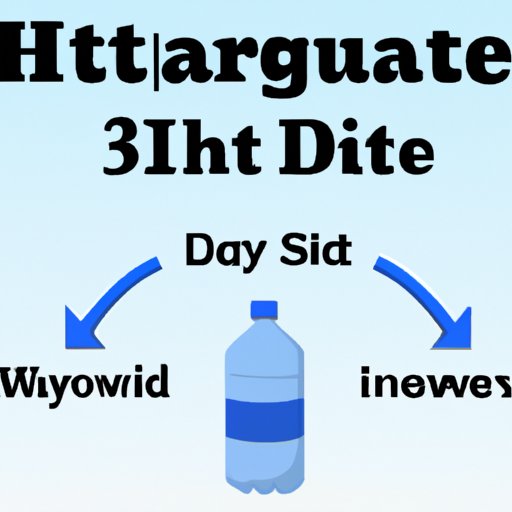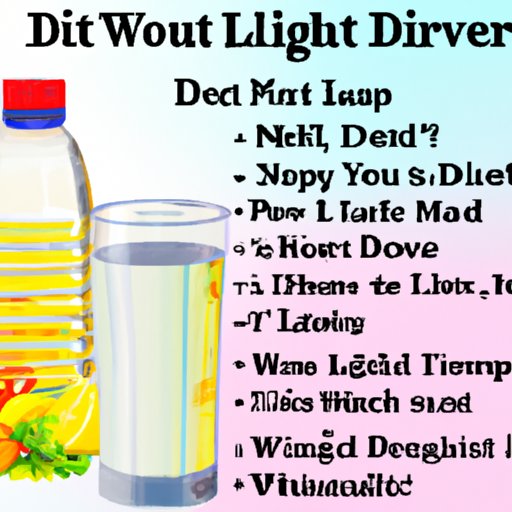Introduction
A liquid diet involves consuming only liquids or foods that can be easily liquefied. It is typically used as a short-term diet plan to help with weight loss, detoxification, or preparation for a medical procedure. Liquid diets have become increasingly popular in recent years, as they offer many health benefits, including improved digestion, increased energy levels, and better overall health. However, there are some risks associated with a liquid diet, such as dehydration and nutrient deficiencies, so it is important to consult with a healthcare professional before beginning this type of diet.
Types of Liquid Diets
There are three main types of liquid diets: clear liquid diet, full liquid diet, and modified liquid diet. Each type has its own set of guidelines and restrictions, so it is important to understand the differences between them before starting a liquid diet.
Clear Liquid Diet
A clear liquid diet consists of only clear liquids that are easy to digest, such as water, tea, coffee, broth, fruit juice, and sports drinks. This type of diet is often recommended by doctors prior to surgery or other medical procedures, as it helps to reduce the amount of food in the stomach and intestines. It is also sometimes used as a short-term weight loss plan.
Full Liquid Diet
A full liquid diet is slightly more substantial than a clear liquid diet, as it allows for the consumption of milk, yogurt, soups, pureed fruits and vegetables, pudding, ice cream, and smoothies. This type of diet is usually recommended for people who need to follow a soft food diet due to digestive issues, or those who are recovering from an illness or injury. It can also be used as a short-term weight loss plan.
Modified Liquid Diet
A modified liquid diet consists of mostly liquids, but also includes protein shakes, protein bars, and soft foods. This type of diet is often recommended by doctors for people who need to restrict their calorie intake, such as those with diabetes or heart disease. It can also be used as a long-term weight loss plan.
How to Prepare for a Liquid Diet
Before starting a liquid diet, it is important to consult with a healthcare professional to ensure it is safe for you. Your doctor can provide guidance on the best type of liquid diet for your individual needs, as well as advise you on any potential risks or side effects. Once you have consulted with your doctor, there are several steps you can take to prepare for a liquid diet:
Consult with a Health Professional
As mentioned above, consulting with a healthcare professional is the first step in preparing for a liquid diet. Your doctor can provide guidance on the best type of diet for your individual needs and make sure that it is safe for you to follow.
Stock Up on Necessary Supplies
Once you have decided on the type of liquid diet you will be following, it is important to stock up on all the necessary supplies. This includes items such as blenders, juicers, shakers, and measuring cups. Make sure to have enough food and beverages on hand to last for the duration of your diet.
Familiarize Yourself with Allowed Foods
Before starting a liquid diet, it is important to familiarize yourself with all the foods and beverages that are allowed. Depending on the type of diet you are following, this list may include water, tea, coffee, broth, fruit juice, sports drinks, milk, yogurt, soups, pureed fruits and vegetables, pudding, ice cream, smoothies, protein shakes, protein bars, and soft foods. Knowing which foods are allowed can help you plan and prepare meals ahead of time.
Plan Ahead for Meal Times
When following a liquid diet, it is important to plan ahead for meal times. This means having all the necessary ingredients on hand and prepping meals in advance. It can also help to create a meal plan to ensure that you are eating a balanced diet and getting all the nutrients your body needs.
What Foods are Allowed on a Liquid Diet?
The types of foods and beverages allowed on a liquid diet vary depending on the type of diet you are following. Here is a breakdown of the most common foods and beverages allowed on each type of liquid diet:
Clear Liquid Diet
The foods and beverages allowed on a clear liquid diet include water, tea, coffee, broth, fruit juice, and sports drinks.
Full Liquid Diet
The foods and beverages allowed on a full liquid diet include milk, yogurt, soups, pureed fruits and vegetables, pudding, ice cream, and smoothies.
Modified Liquid Diet
The foods and beverages allowed on a modified liquid diet include protein shakes, protein bars, and soft foods.

How to Stay Hydrated on a Liquid Diet
Staying hydrated is essential when following a liquid diet, as it helps to keep your body functioning properly and prevents dehydration. Here are some tips for staying hydrated while on a liquid diet:
Drink Plenty of Water
The easiest and most effective way to stay hydrated is to drink plenty of water throughout the day. Aim to drink at least eight 8-ounce glasses of water per day, and more if you are exercising or spending time outdoors.
Include Herbal Teas
Herbal teas are a great way to add flavor and variety to your liquid diet. They are also rich in antioxidants and can help to boost your immune system and improve digestion.
Avoid Caffeinated Beverages
Caffeinated beverages, such as coffee and soda, can cause dehydration, so it is best to avoid them while on a liquid diet. Instead, opt for decaf versions or herbal teas.

Tips for Successfully Completing a Liquid Diet
Following a liquid diet can be challenging, but there are several steps you can take to ensure success. Here are some tips for successfully completing a liquid diet:
Set Reasonable Goals
It is important to set realistic and achievable goals for your liquid diet. Start by setting small, attainable goals and work your way up to larger ones. This will help to keep you motivated and focused on the task at hand.
Track Your Progress
Tracking your progress is a great way to stay on track and monitor your progress. Make sure to keep a journal or log of your meals and activities. This will help you to identify patterns and areas where you may need to make changes.
Eat Regularly
Eating regular meals and snacks is essential when following a liquid diet. Eating regularly will help to keep your energy levels up and prevent feelings of hunger or deprivation.
Listen to Your Body
It is important to listen to your body when following a liquid diet. If you feel overly hungry, tired, or weak, it may be a sign that you need to adjust your diet or take a break. Don’t be afraid to take a break if needed.
Seek Support
Finding support from friends, family, or a healthcare professional can be invaluable when following a liquid diet. Having someone to talk to and lean on can make it easier to stay on track and reach your goals.
Don’t Give Up
Finally, don’t give up if you hit a roadblock or experience a setback. Remember that setbacks are normal and part of the process. Just keep going and remind yourself of why you started the liquid diet in the first place.
Conclusion
A liquid diet can be a great way to jumpstart weight loss, detoxify the body, or prepare for a medical procedure. However, it is important to understand the different types of liquid diets and their associated risks and benefits before starting one. It is also important to consult with a healthcare professional and prepare for the diet by stocking up on supplies and familiarizing yourself with the allowed foods. Finally, it is essential to stay hydrated, set realistic goals, track your progress, eat regularly, listen to your body, seek support, and don’t give up. By following these tips, you can ensure a successful liquid diet experience.
(Note: Is this article not meeting your expectations? Do you have knowledge or insights to share? Unlock new opportunities and expand your reach by joining our authors team. Click Registration to join us and share your expertise with our readers.)
